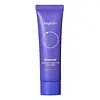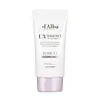What's inside
What's inside
 Key Ingredients
Key Ingredients

 Benefits
Benefits

 Concerns
Concerns

 Ingredients Side-by-side
Ingredients Side-by-side

Water
Skin ConditioningEthylhexyl Triazone
UV AbsorberDibutyl Adipate
EmollientPropanediol
SolventDiethylamino Hydroxybenzoyl Hexyl Benzoate
UV FilterButyloctyl Salicylate
Skin ConditioningNiacinamide
SmoothingBis-Ethylhexyloxyphenol Methoxyphenyl Triazine
Skin ConditioningCI 77891
Cosmetic ColorantCoco-Caprylate/Caprate
Emollient1,2-Hexanediol
Skin ConditioningPolyglyceryl-3 Methylglucose Distearate
EmulsifyingCI 77007
Cosmetic ColorantTromethamine
BufferingDaucus Carota Sativa Root Extract
Skin ConditioningSilica
AbrasiveCarbomer
Emulsion StabilisingAmmonium Acryloyldimethyltaurate/Vp Copolymer
Acrylates/C10-30 Alkyl Acrylate Crosspolymer
Emulsion StabilisingPolyacrylate Crosspolymer-6
Emulsion StabilisingVp/Eicosene Copolymer
Stearyl Alcohol
EmollientCetyl Alcohol
EmollientEthylhexylglycerin
Skin ConditioningPolyglyceryl-6 Polyhydroxystearate
EmulsifyingPolyglyceryl-6 Polyricinoleate
EmulsifyingAluminum Hydroxide
EmollientKaolin
AbrasiveAllantoin
Skin ConditioningTriethoxycaprylylsilane
Adenosine
Skin ConditioningSodium Stearoyl Glutamate
CleansingPolyglycerin-6
HumectantSaccharide Hydrolysate
HumectantBetaine
HumectantCamellia Sinensis Leaf Water
MaskingT-Butyl Alcohol
PerfumingMyristyl Alcohol
EmollientLauryl Alcohol
EmollientTocopherol
AntioxidantAscorbyl Palmitate
AntioxidantWater, Ethylhexyl Triazone, Dibutyl Adipate, Propanediol, Diethylamino Hydroxybenzoyl Hexyl Benzoate, Butyloctyl Salicylate, Niacinamide, Bis-Ethylhexyloxyphenol Methoxyphenyl Triazine, CI 77891, Coco-Caprylate/Caprate, 1,2-Hexanediol, Polyglyceryl-3 Methylglucose Distearate, CI 77007, Tromethamine, Daucus Carota Sativa Root Extract, Silica, Carbomer, Ammonium Acryloyldimethyltaurate/Vp Copolymer, Acrylates/C10-30 Alkyl Acrylate Crosspolymer, Polyacrylate Crosspolymer-6, Vp/Eicosene Copolymer, Stearyl Alcohol, Cetyl Alcohol, Ethylhexylglycerin, Polyglyceryl-6 Polyhydroxystearate, Polyglyceryl-6 Polyricinoleate, Aluminum Hydroxide, Kaolin, Allantoin, Triethoxycaprylylsilane, Adenosine, Sodium Stearoyl Glutamate, Polyglycerin-6, Saccharide Hydrolysate, Betaine, Camellia Sinensis Leaf Water, T-Butyl Alcohol, Myristyl Alcohol, Lauryl Alcohol, Tocopherol, Ascorbyl Palmitate
Water
Skin ConditioningPropanediol
SolventButyloctyl Salicylate
Skin ConditioningTitanium Dioxide
Cosmetic ColorantDibutyl Adipate
EmollientDicaprylyl Carbonate
EmollientDiethylamino Hydroxybenzoyl Hexyl Benzoate
UV FilterPolysilicone-15
UV FilterNiacinamide
SmoothingDiisopropyl Sebacate
EmollientDiphenylsiloxy Phenyl Trimethicone
Skin Conditioning2,3-Butanediol
HumectantEthylhexyl Triazone
UV Absorber1,2-Hexanediol
Skin ConditioningPentylene Glycol
Skin ConditioningTuber Magnatum Extract
Skin ConditioningTocopherol
AntioxidantCoccinia Indica Fruit Extract
Skin ConditioningEclipta Prostrata Extract
Skin ConditioningStellaria Media Extract
Skin ConditioningPortulaca Oleracea Extract
Skin ConditioningHouttuynia Cordata Extract
Skin ConditioningLavandula Angustifolia Flower Extract
CleansingAdansonia Digitata Leaf Extract
Skin ConditioningCentella Asiatica Extract
CleansingBuddleja Davidii Extract
Skin ConditioningOlea Europaea Leaf Extract
PerfumingThymus Vulgaris Extract
PerfumingCitrus Aurantium Dulcis Oil
MaskingSimmondsia Chinensis Seed Oil
EmollientCitrus Nobilis Peel Oil
MaskingLitsea Cubeba Fruit Oil
MaskingSalvia Officinalis Leaf Water
MaskingCentaurea Cyanus Flower Water
Skin ConditioningButylene Glycol
HumectantPolymethylsilsesquioxane
Coco-Caprylate/Caprate
EmollientMethylpropanediol
SolventVp/Eicosene Copolymer
Polyglyceryl-2 Caprate
EmulsifyingGlycerin
HumectantPolyhydroxystearic Acid
EmulsifyingSucrose Stearate
EmollientAmmonium Acryloyldimethyltaurate/Vp Copolymer
Polyacrylate Crosspolymer-6
Emulsion StabilisingInulin Lauryl Carbamate
Emulsion StabilisingHydroxypropyl Methylcellulose Stearoxy Ether
Stearic Acid
CleansingEthylhexylglycerin
Skin ConditioningAlumina
AbrasiveGlyceryl Caprylate
EmollientAluminum Hydroxide
EmollientTriethoxycaprylylsilane
Xanthan Gum
EmulsifyingAdenosine
Skin ConditioningSqualane
EmollientPolyether-1
Lactobacillus Ferment
Skin ConditioningGlutathione
Allantoin
Skin ConditioningPanthenol
Skin ConditioningCaesalpinia Spinosa Gum
Skin ConditioningBiosaccharide Gum-1
HumectantHydrolyzed Hyaluronic Acid
HumectantMaltodextrin
AbsorbentWine
Skin ConditioningUltramarines
Limonene
PerfumingWater, Propanediol, Butyloctyl Salicylate, Titanium Dioxide, Dibutyl Adipate, Dicaprylyl Carbonate, Diethylamino Hydroxybenzoyl Hexyl Benzoate, Polysilicone-15, Niacinamide, Diisopropyl Sebacate, Diphenylsiloxy Phenyl Trimethicone, 2,3-Butanediol, Ethylhexyl Triazone, 1,2-Hexanediol, Pentylene Glycol, Tuber Magnatum Extract, Tocopherol, Coccinia Indica Fruit Extract, Eclipta Prostrata Extract, Stellaria Media Extract, Portulaca Oleracea Extract, Houttuynia Cordata Extract, Lavandula Angustifolia Flower Extract, Adansonia Digitata Leaf Extract, Centella Asiatica Extract, Buddleja Davidii Extract, Olea Europaea Leaf Extract, Thymus Vulgaris Extract, Citrus Aurantium Dulcis Oil, Simmondsia Chinensis Seed Oil, Citrus Nobilis Peel Oil, Litsea Cubeba Fruit Oil, Salvia Officinalis Leaf Water, Centaurea Cyanus Flower Water, Butylene Glycol, Polymethylsilsesquioxane, Coco-Caprylate/Caprate, Methylpropanediol, Vp/Eicosene Copolymer, Polyglyceryl-2 Caprate, Glycerin, Polyhydroxystearic Acid, Sucrose Stearate, Ammonium Acryloyldimethyltaurate/Vp Copolymer, Polyacrylate Crosspolymer-6, Inulin Lauryl Carbamate, Hydroxypropyl Methylcellulose Stearoxy Ether, Stearic Acid, Ethylhexylglycerin, Alumina, Glyceryl Caprylate, Aluminum Hydroxide, Triethoxycaprylylsilane, Xanthan Gum, Adenosine, Squalane, Polyether-1, Lactobacillus Ferment, Glutathione, Allantoin, Panthenol, Caesalpinia Spinosa Gum, Biosaccharide Gum-1, Hydrolyzed Hyaluronic Acid, Maltodextrin, Wine, Ultramarines, Limonene
 Reviews
Reviews

Ingredients Explained
These ingredients are found in both products.
Ingredients higher up in an ingredient list are typically present in a larger amount.
1,2-Hexanediol is a synthetic liquid and another multi-functional powerhouse.
It is a:
- Humectant, drawing moisture into the skin
- Emollient, helping to soften skin
- Solvent, dispersing and stabilizing formulas
- Preservative booster, enhancing the antimicrobial activity of other preservatives
Adenosine is in every living organism. It is one of four components in nucleic acids that helps store our DNA.
Adenosine has many benefits when used. These benefits include hydrating the skin, smoothing skin, and reducing wrinkles. Once applied, adenosine increases collagen production. It also helps with improving firmness and tissue repair.
Studies have found adenosine may also help with wound healing.
In skincare products, Adenosine is usually derived from yeast.
Learn more about AdenosineAllantoin is a soothing ingredient known for its protective and moisturizingg properties. Because of this, it is often added to products with strong active ingredients.
Studies show higher concentrations of this ingredient can promote wound healing.
Though it can be derived from the comfrey plant, allantoin is produced synthetically for cosmetic products to ensure purity.
Learn more about AllantoinAluminum Hydroxide is a form of aluminum. It can be naturally found in nature as the mineral gibbsite. In cosmetics, Aluminum Hydroxide is used as a colorant, pH adjuster, and absorbent.
As a colorant, Aluminum Hydroxide may add opacity, or reduce the transparency. Aluminum hydroxide is contains both basic and acidic properties.
According to manufacturers, this ingredient is an emollient and humectant. This means it helps hydrate the skin.
In medicine, this ingredient is used to help relieve heartburn and help heal ulcers.
There is currently no credible scientific evidence linking aluminum hydroxide in cosmetics to increased cancer risk.
Major health organizations allow the use of aluminum hydroxide in personal care products and have not flagged it as a carcinogenic risk at typical usage levels.
Learn more about Aluminum HydroxideAmmonium Acryloyldimethyltaurate/Vp Copolymer (let's call it AAVC for short) is a synthetically created polymer. It's used as a film-forming agent and used to thicken the consistency of products.
AAVC is able to increase the consistency and viscosity of products due to its large molecule size. It also prevents ingredients from separating.
Butyloctyl Salicylate is a chemical UV filter structurally similar to octisalate. It is a photostabilizer, SPF booster, emollient and solvent. This ingredient helps evenly spread out ingredients.
According to a manufacturer, it is suitable for pairing with micro Titanium Dioxide, Zinc Oxide, and pigments.
Photostabilizers help stabilize UV-filters and prevents them from degrading quickly.
Learn more about Butyloctyl SalicylateCoco-Caprylate/Caprate is created from fatty coconut alcohol, caprylic acid, and capric acid.
It is a lightweight emollient. Emollients create a thin barrier on the skin to trap moisture in. This helps keep your skin hydrated and soft.
Once applied, Coco-Caprylate/Caprate is absorbed quickly and leaves a silky feel.
Coco-Caprylate/Caprate may not be fungal acne safe.
Learn more about Coco-Caprylate/CaprateDibutyl Adipate is an emollient and solvent. It is created from butyl alcohol and adipic acid.
As a solvent, Dibutyl Adipate helps mix and disperse ingredients evenly.
Dibutyl Adipate is soluble in water and organic solvents. It does not absorb UV rays.
Learn more about Dibutyl AdipateDiethylamino Hydroxybenzoyl Hexyl Benzoate (DHHB) is a chemical UV-A absorber. It is formulated for high UVA protection (320-400 nm).
DHHB is well-liked for:
DHHB has been approved by the EU, Japan, Taiwan, and South America for use up to 10%. Unfortunately, it has not been approved for use in the US or Canada due to slow regulatory processes.
This ingredient is soluble in oils, fats, and lipids.
Learn more about Diethylamino Hydroxybenzoyl Hexyl BenzoateEthylhexyl Triazone is a modern chemical sunscreen that protects from UV-B radiation.
It is the most effective of existing UV-B filters, as it provides the highest level of photo-stable absorption. It protects from the entire UV-B range (280 to 320nm), with it's highest level of protection at 314nm.
Ethylhexyl Triazone is oil soluble, oderless and colorless, which mean it is able to be incorporated into a variety of different formulations.
It is not currently available within the United States due to slow changing FDA regulations. Outside of the US, it is used in formulations at concentrations up to 5%.
Learn more about Ethylhexyl TriazoneEthylhexylglycerin (we can't pronounce this either) is commonly used as a preservative and skin softener. It is derived from glyceryl.
You might see Ethylhexylglycerin often paired with other preservatives such as phenoxyethanol. Ethylhexylglycerin has been found to increase the effectiveness of these other preservatives.
Niacinamide is a multitasking form of vitamin B3 that strengthens the skin barrier, reduces pores and dark spots, regulates oil, and improves signs of aging.
And the best part? It's gentle and well-tolerated by most skin types, including sensitive and reactive skin.
You might have heard of "niacin flush", or the reddening of skin that causes itchiness. Niacinamide has not been found to cause this.
In very rare cases, some individuals may not be able to tolerate niacinamide at all or experience an allergic reaction to it.
If you are experiencing flaking, irritation, and dryness with this ingredient, be sure to double check all your products as this ingredient can be found in all categories of skincare.
When incorporating niacinamide into your routine, look out for concentration amounts. Typically, 5% niacinamide provides benefits such as fading dark spots. However, if you have sensitive skin, it is better to begin with a smaller concentration.
When you apply niacinamide to your skin, your body converts it into nicotinamide adenine dinucleotide (NAD). NAD is an essential coenzyme that is already found in your cells as "fuel" and powers countless biological processes.
In your skin, NAD helps repair cell damage, produce new healthy cells, support collagen production, strengthen the skin barrier, and fight environmental stressors (like UV and pollution).
Our natural NAD levels start to decline with age, leading to slower skin repair, visible aging, and a weaker skin barrier. By providing your skin niacinamide, you're recharging your skin's NAD levels. This leads to stronger, healthier, and younger looking skin.
Another name for vitamin B3 is nicotinamide. This vitamin is water-soluble and our bodies don't store it. We obtain Vitamin B3 from either food or skincare. Meat, fish, wheat, yeast, and leafy greens contain vitamin B3.
The type of niacinamide used in skincare is synthetically created.
Learn more about NiacinamidePolyacrylate Crosspolymer-6 is a texture enhancer and pH adjuster.
It is be used to thicken water-based products and create a gel-texture with a velvet feel.
One manufacturer claims this ingredient to have a pH range of 2-8 and to be biodegradable.
Learn more about Polyacrylate Crosspolymer-6Propanediol is an all-star ingredient. It softens, hydrates, and smooths the skin.
It’s often used to:
Propanediol is not likely to cause sensitivity and considered safe to use. It is derived from corn or petroleum with a clear color and no scent.
Learn more about PropanediolTocopherol (also known as Vitamin E) is a common antioxidant used to help protect the skin from free-radicals and strengthen the skin barrier. It's also fat soluble - this means our skin is great at absorbing it.
Vitamin E also helps keep your natural skin lipids healthy. Your lipid skin barrier naturally consists of lipids, ceramides, and fatty acids. Vitamin E offers extra protection for your skin’s lipid barrier, keeping your skin healthy and nourished.
Another benefit is a bit of UV protection. Vitamin E helps reduce the damage caused by UVB rays. (It should not replace your sunscreen). Combining it with Vitamin C can decrease sunburned cells and hyperpigmentation after UV exposure.
You might have noticed Vitamin E + C often paired together. This is because it is great at stabilizing Vitamin C. Using the two together helps increase the effectiveness of both ingredients.
There are often claims that Vitamin E can reduce/prevent scarring, but these claims haven't been confirmed by scientific research.
Learn more about TocopherolTriethoxycaprylylsilane is a silicone used to bind and stabilize ingredients.
As an emulsifier, it helps prevent ingredients from separating. This can help elongate the shelf life of products.
Triethoxycaprylylsilane is often used to coat mineral sunscreens ingredients to help give a better feel. It also helps reduce oxidative stress in sunscreens.
Learn more about TriethoxycaprylylsilaneWe don't have a description for Vp/Eicosene Copolymer yet.
Water. It's the most common cosmetic ingredient of all. You'll usually see it at the top of ingredient lists, meaning that it makes up the largest part of the product.
So why is it so popular? Water most often acts as a solvent - this means that it helps dissolve other ingredients into the formulation.
You'll also recognize water as that liquid we all need to stay alive. If you see this, drink a glass of water. Stay hydrated!
Learn more about Water